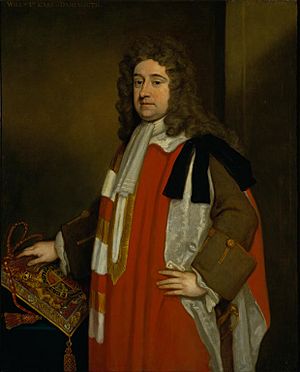William Legge, 1st Earl of Dartmouth facts for kids
Quick facts for kids
The Earl of Dartmouth
|
|
|---|---|

Portrait by Godfrey Kneller
|
|
| Southern Secretary | |
| In office 1710–1713 |
|
| Preceded by | The Earl of Sunderland |
| Succeeded by | The Viscount Bolingbroke |
| Lord Privy Seal | |
| In office 1713–1714 |
|
| Preceded by | John Robinson |
| Succeeded by | The Marquess of Wharton |
| Personal details | |
| Born | 14 October 1672 |
| Died | 15 December 1750 (aged 78) |
| Spouse | Anne Finch |
| Education | Westminster School |
| Alma mater | King's College, Cambridge |
William Legge, 1st Earl of Dartmouth (born October 14, 1672 – died December 15, 1750) was an important British politician. He served as the Lord Privy Seal from 1713 to 1714. He was a member of the Tory Party, supporting the idea that the Hanover family should rule Britain after Queen Anne died.
Template:TOC limit=3
Contents
Who Was William Legge?
William Legge was the only son of George Legge, 1st Baron Dartmouth. He was born into a noble family. His father was also an important figure.
Early Life and Education
William Legge went to Westminster School as a boy. After that, he studied at King's College, Cambridge. He earned his Master of Arts degree there in 1689. In 1691, he inherited his father's title, becoming the 2nd Baron Dartmouth.
His Political Career
William Legge began his public service in 1702. He was appointed to the Board of Trade and Plantations. This group helped manage trade and colonies.
Eight years later, in 1710, he became the Secretary of State for the Southern Department. This was a very important job. He also helped manage official documents for Scotland.
In 1711, he was given two new titles: Viscount Lewisham and Earl of Dartmouth. This showed his growing importance. In 1713, he changed roles to become the Lord Privy Seal. He held this position until late 1714.
After this, he mostly stayed out of public life. He passed away on December 15, 1750.
His Political Style
William Legge was known for being a moderate politician. Even though he was a Tory, he was willing to work with the Whig Party. He believed in finding common ground.
He earned the respect of Robert Harley, another politician who favored moderation. Dartmouth remained a loyal friend to Harley.
Queen Anne trusted him a lot. She even called him "an honest man." As a government minister, he was not flashy, but he was competent. He worked hard and was known for being very discreet. Foreign ambassadors found it hard to get information from him.
In his private life, he enjoyed telling jokes. He often laughed at his own jokes, which earned him the nickname "the Jester."
His Family Life
Lord Dartmouth married Lady Anne Finch in July 1700. She was the third daughter of Heneage Finch, 1st Earl of Aylesford. They had six children together.
- George Legge, Viscount Lewisham (born around 1704, died 1732). He was the father of William Legge, 2nd Earl of Dartmouth.
- Lady Barbara Legge (born 1701, died 1765). She married Sir Walter Bagot, 5th Baronet.
- Hon. Heneage Legge (born 1704, died 1759).
- Lady Anne Legge (born 1705, died 1740). She married Sir Lister Holte, 5th Baronet.
- Rt Hon. Henry Bilson-Legge (born 1708, died 1764). He became the Chancellor of the Exchequer three times.
- Commodore Hon. Edward Legge (born 1710, died 1747). He was a naval officer.
William Legge was succeeded by his grandson, William Legge, 2nd Earl of Dartmouth. This happened because his eldest son, George Legge, died before him.
The Dartmouth family lived at a place called Sandwell Hall. This building has since been taken down.
Lasting Impact
The city of Dartmouth in Nova Scotia, Canada, is named after him. This shows his lasting legacy.
Images for kids


